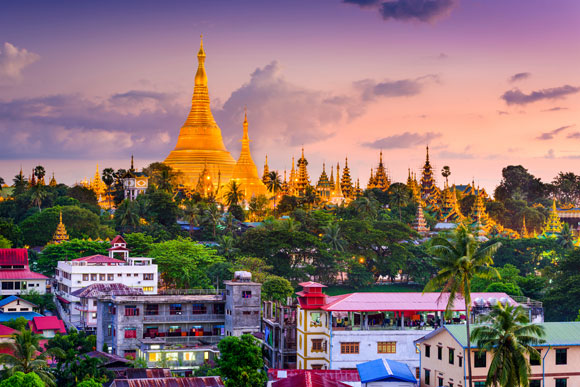Now is the ideal time to enjoy Burma before masses of tourists flood in. ©iStock.com/Sean Pavone
Five decades after locking itself away from the world, Burma has opened up to tourism in a big way. And Yangon, its capital formerly known as Rangoon, is becoming a major destination for people who want to see the renaissance of what was, a century ago, one of the region’s most beautiful and cosmopolitan cities. It was (and still is) home to a stock of surviving British colonial-era architecture unparalleled in Southeast Asia.
Having only a few fancy hotels, starred restaurants, and chic nightclubs, Yangon is unlikely to attract high-flying tourists. But with the increasing international investment in Burma, those amenities will undoubtedly come. Now is your chance to see a city re-awakening from a deep sleep. Yangon still has its traditional markets, the street barber with an umbrella and chair as his salon, and the benign shambles that make Southeast Asia so intriguing, but which have sadly been lost in so many other countries.
A $2 taxi ride from the Strand Hotel, the city’s central gem, and you’re at Bogyoke Aung San Market. For almost 100 years, this has been the rare-gems center of Yangon, especially for Burma-mined rubies and jade. The number of government-licensed jewelry shops testifies to the popularity of gold and rare stones in Burma, but the market is also a huge arcadia of fashion.
Filter through the arches, and you find vendors selling lengths from piles of brilliantly colored fabrics. In tiny workshops nearby, seamstresses mark patterns while sitting cross-legged on the floor. Others work antique treadle sewing machines with fanciful names like “The Flying Man.” A few steps further, nimble-fingered young girls pick up the tiniest of beads on the point of a needle with dextrous rapidity, using them as appliqué for fancy dresses. You can choose your fabric length, have it sewn into a style of your choice, add the buttons and brocade, and be dressed in it by the time you can walk halfway up the narrow alleyway. An outfit completed from scratch in 30 feet and four tiny shops. If you’re after a blouse and a skirt, figure on having them both made for around $5.50.
While in the area, take the 15-minute walk to Yangon Central Railway Station for an experience most visitors overlook. As rewarding as any sight-seeing tour, a ride on the local train that loops around Yangon is a chance to see how life is lived on the other side of the tracks…or, in this case, on both sides of the track and inside the train, as well.
Between 6 a.m. and 5 p.m., the trains of the Yangon Circular Railway leave Platform 7 of the Central Railway Station, off Bogyoke Aung Sang Road. Train departures alternate traveling in a clockwise and counter-clockwise direction. For three hours they collect and deposit commuters, clacking their way in a loop through 39 stations on a 28-mile circuit, for which you pay the princely sum of 200 kyat—16 cents.
As the train leaves the station, vendors move through the central aisle. Quail eggs, toothbrushes, soft drinks, and fruit, all sold from baskets carried on ladies’ heads. Elegantly dressed in a white high-collared shirt and checked sarong, a charming vendor with a winning smile will prepare you a delicious snack from his tray of small pancakes, shredded vegetables, and bottles of mystical sauces—all for only 15 cents.
Have your camera ready for Danyingon, almost half-way around the circuit. On the station platform on either side of the track, a large fruit and vegetable market glitters in bold Technicolor. Vendors sit under huge, brightly colored umbrellas, shading themselves and their mounds of produce from the pitiless monsoon or ferocious summer sun. Freshly boiled corncobs for snacking; peeled and sliced mangos for juices; mounds of fruit and vegetables, most of which I didn’t recognize, for housewives to pick and haggle over; skewers of sausages and bananas gently grilling…they all create a snapshot of life on the rim of a great metropolis.
Street food in Yangon is everywhere, cheap, and usually very tasty. But there is one specialty, unique to Myanmar, that you should try, if for no other reason than to say you’ve done it.
On almost every street, at almost any time of day, you will see low plastic stools set around a knee-high portable kitchen. At its center, in a semi-circular cauldron, a rich brown gravy simmers. In upper-class kitchens, skewers of sliced meats are arrayed decoratively in a fan shape around the edge of the pan; in lower-class ones you will see a mound of innards and gizzards, fat tongues, and sponge-like tripe. Whatever the display, the constituent parts are the same: all those bits of the pig that come under the gastronomic description of “everything but the squeal.” Street sweepers sit next to secretaries next to students, and for 100 kyat (8 cents) per wooden skewer, they can have a modest snack or intestinal blow-out.
The procedure is to take a skewer with the slice of pre-cooked meat and warm it in the gravy for 30 seconds, dip it into the slightly sweet-and-sour sauce in a bowl in front of you, then eat it.
For something more conventional, try Monsoon, on Thein Phyu Road. This delightfully peaceful spot specializes in dishes from the countries covered by the monsoon. Burma, Thailand, Vietnam, Cambodia, and Laos are all represented. The dishes’ apparent simplicity does not diminish their flavor: Consider nga phe ohn no cbet (fish cake in coconut curry from Burma) or keng onsol mak fak khen (stir-fried morning glory from Laos). A delicious sampling of Asia for around $5.50 a dish.

